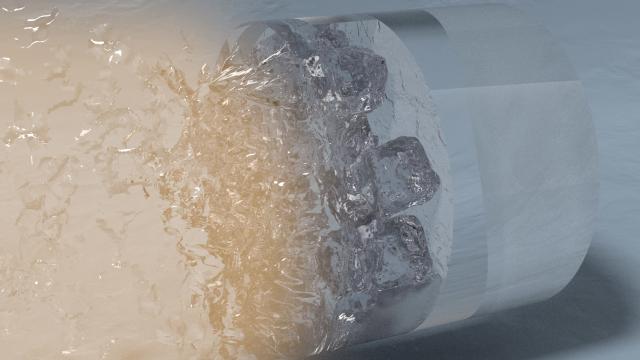Scientists used high-energy lasers to create a new phase of ice unlike any seen on Earth before—but which might exist deep within Neptune and Uranus.
Water’s structure allows it to freeze into many different crystalline forms (including ice-IX, which does not share the same properties as the Ice-IX from Kurt Vonnegut’s Cat’s Cradle). Perhaps one of the strangest forms is supersonic ice, where hydrogen atoms whizz around like a liquid through a solid oxygen-only crystal. Superionic ice could be important for understanding how ice giant planets evolved. With the help of x-rays and lasers, scientists were recently able to produce and measure this ice in the lab.
Researchers first predicted the existence of superionic ice in 1988, and first observed evidence of its existence in 2018. New methods have allowed scientists to actually observe its atomic structure.
The scientists squeezed water molecules between a pair of diamonds, then shot the sample with six high-powered laser beams in a specialised, 15-nanosecond-long sequence using the University of Rochester’s Laboratory for Laser Energetics’ Omega laser. This produces shock waves in between the diamonds, compressing the water molecules to pressures around the same as those at the center of Earth and temperatures about half that of the Earth’s core. (You might think that ice is supposed to be cold, but matter is sensitive to both temperature and pressure. That means that at really high pressures, water can turn to ice at temperatures you’d expect it to be a liquid or a gas.) Immediately after the laser pulse, they shoot the sample with x-rays, which allows them to measure the structure of what they’ve produced. The biggest challenge was measuring the sample quickly enough after creating the ice to generate an unambiguous detection signature.
“Given the extreme conditions at which this elusive state of matter is predicted to be stable, compressing water to such pressures and temperatures and simultaneously taking snapshots of the atomic structure was an extremely difficult task, which required an innovative experimental design,” study author Federica Coppari said in press release from Lawrence Livermore National Laboratory.
And their efforts were successful, Coppari said. There’ve been other pieces of evidence pointing toward the existence of this superionic ice. But x-ray diffraction measurements are a crucial confirmation. The team has proposed naming their ice XVIII.
“This study brings the last missing piece to the puzzle regarding the existence of superionic water ice, 30 years after the original prediction,” the authors write in the study published in Nature.
Superionic ice is more than just a curiosity. “We think it makes up the bulk of the mass of both Uranus and Neptune,” Jonathan Fortney, director of the Other Worlds Laboratory at the University of California, Santa Cruz, told Gizmodo. If these planets are full of this weird form of ice, scientists might need to re-think their models of how heat flows through these worlds and how they cool over time.
The researchers still hope to perform measurements at higher temperatures and pressures to fully flush out the nature of this ice, and to understand the pressures at which ice takes on this superionic form.
Our everyday experiences are limited to the temperatures and pressures that are common here on Earth. It’s easy to forget just how many wild states of matter with strange properties might exist in other realms.
